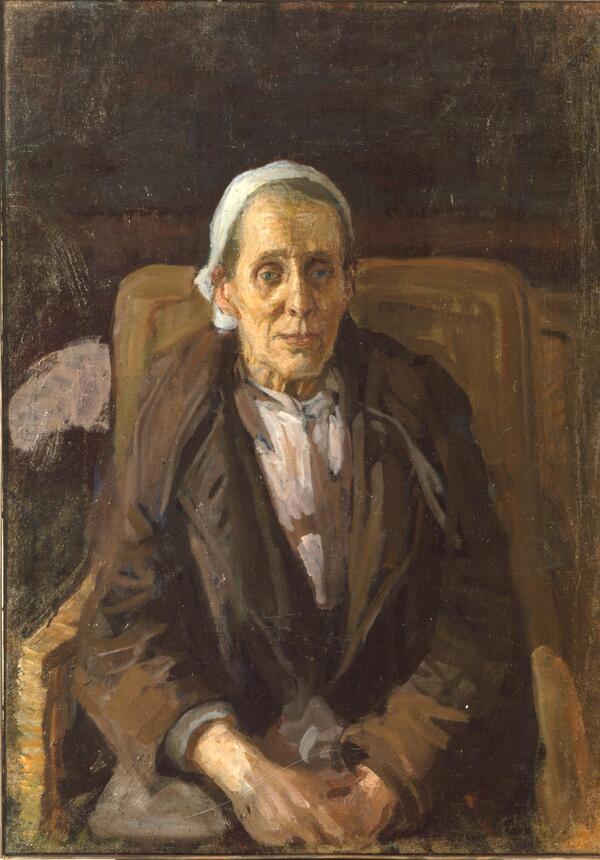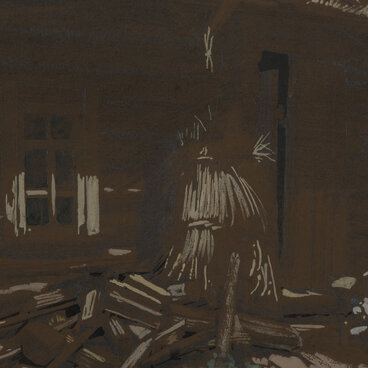The Ostrogozhsk Museum of History and Art houses one of the few surviving paintings by Mitrofan Semyonovich Fyodorov — the portrait of the nanny of the artist’s son.
The talented painter Mitrofan Fyodorov was born into a large family of a village priest from Ostrogozhsky Uyezd, Voronezh Governorate. When the boy was nine years old, his father died. His mother managed to single-handedly provide all her children with education. Just like his brothers, Mitrofan graduated from the Voronezh Theological Seminary. When he studied there, he became interested in fine arts. During that time, there were drawing classes in the seminary curriculum, and the genius artist and teacher Lev Grigoryevich Solovyov was widely known and respected in the city. When the young seminary student asked Solovyov to give him drawing lessons, the artist took him outside and explained to him that he never gave anyone lessons and that all the great artists learned from nature. Still, Lev Solovyov eventually became his friend and teacher for many years.
Having graduated from the seminary, Mitrofan Fyodorov taught at a zemstvo school and later went to study at the Academy of Arts in St. Petersburg. One of his teachers there was the famous Ilya Repin. After graduating from the Academy, Fyodorov went on an internship trip to Italy and Germany, and after returning, he worked at the Kharkiv Art School.
This portrait depicts Praskovya Nikiforovna Nikiforova (1868–1942) who babysat with the artist’s children. The woman answered an advertisement and started working for the Fyodorov family when she was 35. The Fyodorovs had three children. Praskovya Nikiforova dedicated her entire life to them. Apparently, she was a truly remarkable person. In his letters to his daughters who lived abroad, Fyodorov wrote, “…how favorable has fortune been to us in giving you such a wonderful person, such a guardian angel. I have never met a person with a more beautiful and pure soul.” The monochromatic color palette, dim lighting, humble interior, and poor clothes speak volumes: they reflect the time period, the artist’s attitude toward his sitter, and his state of mind.
Mitrofan Fyodorov died in the besieged Leningrad in 1941. By a twist of fate, his descendants stayed abroad. Unfortunately, most of the paintings that the artist donated to the Ostrogozhsk Museum, were lost during the war.
The talented painter Mitrofan Fyodorov was born into a large family of a village priest from Ostrogozhsky Uyezd, Voronezh Governorate. When the boy was nine years old, his father died. His mother managed to single-handedly provide all her children with education. Just like his brothers, Mitrofan graduated from the Voronezh Theological Seminary. When he studied there, he became interested in fine arts. During that time, there were drawing classes in the seminary curriculum, and the genius artist and teacher Lev Grigoryevich Solovyov was widely known and respected in the city. When the young seminary student asked Solovyov to give him drawing lessons, the artist took him outside and explained to him that he never gave anyone lessons and that all the great artists learned from nature. Still, Lev Solovyov eventually became his friend and teacher for many years.
Having graduated from the seminary, Mitrofan Fyodorov taught at a zemstvo school and later went to study at the Academy of Arts in St. Petersburg. One of his teachers there was the famous Ilya Repin. After graduating from the Academy, Fyodorov went on an internship trip to Italy and Germany, and after returning, he worked at the Kharkiv Art School.
This portrait depicts Praskovya Nikiforovna Nikiforova (1868–1942) who babysat with the artist’s children. The woman answered an advertisement and started working for the Fyodorov family when she was 35. The Fyodorovs had three children. Praskovya Nikiforova dedicated her entire life to them. Apparently, she was a truly remarkable person. In his letters to his daughters who lived abroad, Fyodorov wrote, “…how favorable has fortune been to us in giving you such a wonderful person, such a guardian angel. I have never met a person with a more beautiful and pure soul.” The monochromatic color palette, dim lighting, humble interior, and poor clothes speak volumes: they reflect the time period, the artist’s attitude toward his sitter, and his state of mind.
Mitrofan Fyodorov died in the besieged Leningrad in 1941. By a twist of fate, his descendants stayed abroad. Unfortunately, most of the paintings that the artist donated to the Ostrogozhsk Museum, were lost during the war.



